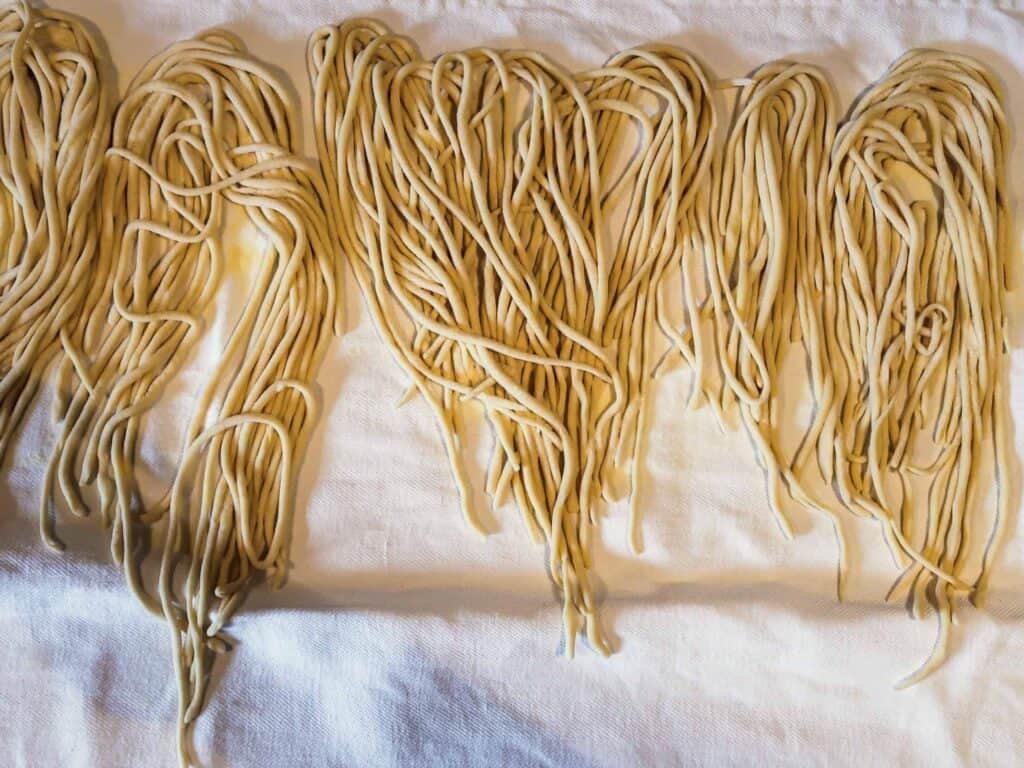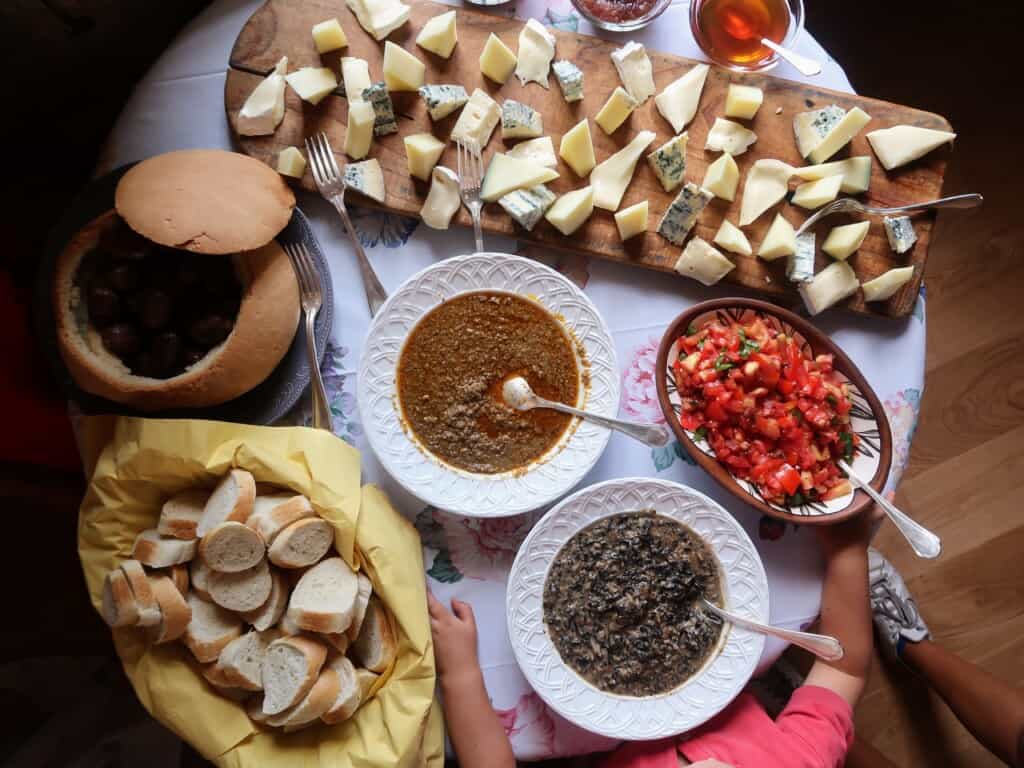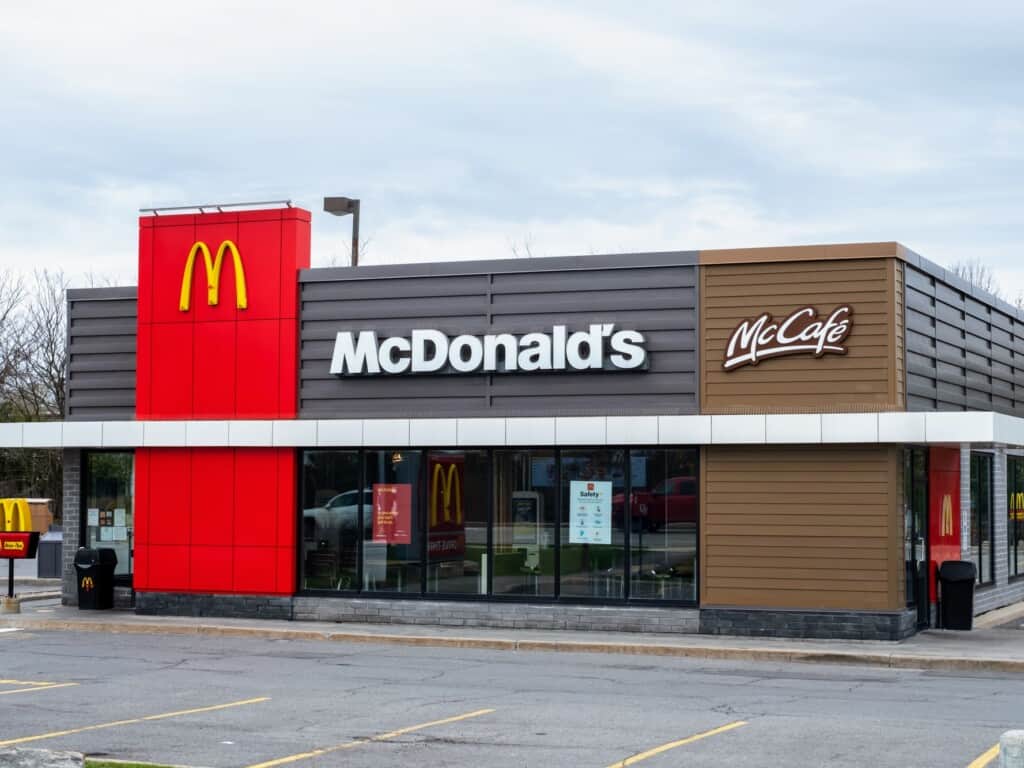Last updated on December 31st, 2024
Chances are that you, like most of us, are confused about the Italian dinner structure and the different Italian dinner courses. Why are there so many courses? Do you really eat them all? Can you go to a restaurant and only order one or two?
For answers to these questions, keep reading! I have been eating dinner in Italy for over 20 years as a traveler and now as a mom of four in Tuscany.
In this guide to Italian dinner courses, I will cover:
- the time frame for Italian dinners
- what the different Italian dinner courses are
- what to expect at dinner in Italy
- the most common dishes
- Italian dinner structure
- etiquette when ordering
- what most Italians practice in a modern day culture, guided by business hours and complicated weekday routines
Eating in Italy Basics: Check out my Visitor’s Guide to Eating in Italy.
Jump to Section
When Do Italians Eat Dinner?

Italians eat dinner quite late compared to US standards. Italians usually sit down to the dinner table between 8:00 pm and 10:00 pm, depending on the time of year and region.
In Italy, the climate really dominates the dinner times. In warmer regions, they eat later, especially in the summer because it’s just too hot to cook earlier, as late as even 10:00 pm in places like Basilicata and Calabria.
In northern regions like Veneto and Trentino-Alto Adige, the mountain climate is mild and temperate so Italians can eat on the earlier side.
In the winter, Italians eat earlier because of the shorter days but still, we are talking 8:00 pm, generally not earlier. All this being said, the aperitivo hour is going to start earlier than the meal.
Learn More: Read What Time Do Italians Eat Dinner?
Italian Dinner Courses And Structure Quick Guide
| Course | English Translation | Time | What Is Served |
| Aperitivo | Cocktails/Aperitif | 6:00-8:30 pm | A light drink and a small salty nibble – cin cin! |
| Antipasto | Appetizer/Starter | 8:00-10:00 pm | Appetizers such as cheese and charcuterie boards, crostini, seafood salads, tartar. |
| Primo | First course | 15-20 minutes after antipasto | First course carb-heavy dishes such as pastas, rice, polenta and soups |
| Secondo | Second course | 15-30 minutes after primo | Second course meats, fish and eggs such as stews, whole fish, seafood dishes and egg omelets and souffles. |
| Contorno | Side dish | Served with second course | Side dishes accompanying second course like vegetables and potatoes |
| Insalata | Salad | Served with second course | Side salads generally served with the second course |
| Dolce (Frutta & Formaggio) | Dessert (Fruit & Cheese) | 10-15 minutes after second course | Dessert including either a regional specialty, fruit or an aged cheese |
| Caffè | Coffee | 5-10 minutes after dessert | Coffee, always espresso |
| Digestivo | Digestif | Ordered and served at leisure after coffee, typically within 20 minutes. | A nightcap or after dinner digestive drink such as grappa |
Good To Know: Italian proportions are modest and the timing is leisurely, making it easy to eat multiple courses.
Dinner Etiquette In Italy
You are probably wondering if Italians really eat every single course? The short answer is no but like all Italian food rules and etiquette, there are plenty of exceptions and explanations needed.
Dinner At A Restaurant in Italy

Generally speaking when Italians eat out, they will order at least two categories from the menu (antipasto, primo, secondo + contorno, dolce) plus coffee. For example, they may have a primo and a secondo + contorno. Another formula might be an antipasto and a primo. You could also order an antipasto and secondo + contorno. They then might or might not have a dessert, and usually have coffee.
Good To Know: The second course and contorno (side dish), while ordered separately, are considered one in the same. Italians won’t typically just order a contorno or just a secondo.
Now because we are also talking about a business-oriented society in many parts of Italy (big cities), in which people only have an hour for lunch, many new lunch spots have cropped up in cities, offering lunch specials and formulas at a single price.
For example, you might get 1 primo, 1 water, 1 glass of wine and 1 coffee for €12.00 or 1 secondo + contorno, 1 water, 1 glass of wine and 1 coffee for €15.00. In this case, you are expected to just order one. After all, no one, not even Italians these days, have time for a multi-course meal when working a 9:00-5:00 job!
Exception: At large celebrations, Sunday lunches or family gatherings, it’s not uncommon to be served every single course at a restaurant. You will be given ample time between courses to aid in the digestion and usually, the portions are not enormous.
Learn More: Read about the Different Types of Italian Eateries – From Trattorie to Osterie and more!
Dinner At Home in Italy

Because many Italians work outside the home Monday-Friday, the old traditions of coming home for lunch have slowly died out. Despite this,, the idea of sitting down with family and enjoying a meal is still very symbolic for Italians. Today, dinner is often the family-oriented, larger meal of the day (but not always), when Italians take time to sit down, talk with one another and break bread together.
I would say that every family does it differently. In many rural areas, traditional families still uphold the tradition of eating first and second courses every night but if both parents work, kids have overlapping schedules, and everyone is always in a rush, it’s more likely that families will sit down for either a first or second course together, not both at the same time. When this happens, they call it un piatto unico or a single dish, meaning that it’s all-inclusive. If anything, there might be a side dish to supplement a simple first course meal with a vegetable.
For example, if a family is having a pasta al ragù (pasta with meat sauce) for dinner or tortellini in brodo (tortellini served with a chicken or beef stock), they might also have a side salad, steamed vegetable or sauteed greens afterwards but not necessarily with a second course as well.
Good To Know: Traditional dinner structure is still widespread in southern Italy and in the rural countryside where the pace of life is still relatively slow compared to the hustle and bustle of city centers.
Cook Like an Italian: Check out Delicious Dinner Recipes That We Actually Make in Italy.
Aperitivo (Aperitif)

Aperitivo Hour: Between 6:00 pm and 8:30 pm
The aperitivo is what you will be starting your meal with, typically a light drink and a small nibble, but never takes place in the same place you are actually eating your meal. You might have an aperitivo at a bar and then move next door to a trattoria restaurant. You would never have an aperitivo within the restaurant.
Fact: It’s uncommon for traditional Italian restaurants to have bars within the restaurant. The restaurant is dedicated to eating, not drinking (although you will be drinking with your meal).

Traditional aperitivo drinks:
- Campari Soda
- Crodino or Crodino Spritz (non-alcoholic)
- Aperol spritz
- Campari spritz
- Prosecco
- Glass of white wine
- Beer
Good To Know: Cocktails are less commonly enjoyed for aperitivo than the drinks listed above because the idea is to keep things light, not to get knackered before a meal. Of course, Italians do drink cocktails as aperitifs but it’s not an everyday affair.
Whatever drink you choose, you will be served a small nibble to accompany that drink, most typically olives, nuts, a bit of cheese or squares of focaccia or potato chips. Remember, Italians don’t typically snack so they are going to want a tiny salty bite to cut their beverage.
Learn More: To get the low-down on the tradition of aperitif time in Italy read Aperitivo In Italy – How Italians Do Pre-dinner Drinks + How To Recreate It At Home.
Good To Know: If you’ve got teens with you, read about the Drinking Age in Italy.
Learn More: Read more about Where to Drink Wine in Italy and Where to Buy Wine in Italy.
Antipasto (Appetizer)

The Antipasto is the equivalent of a starter or appetizer. The range of dishes served for antipasti varies greatly depending on the region you are in. Think something small, a couple of bites, like cured meats, various regional cheese, crostini, bruschetta, a bit of fried fish or tartar.
Primo (First Course)
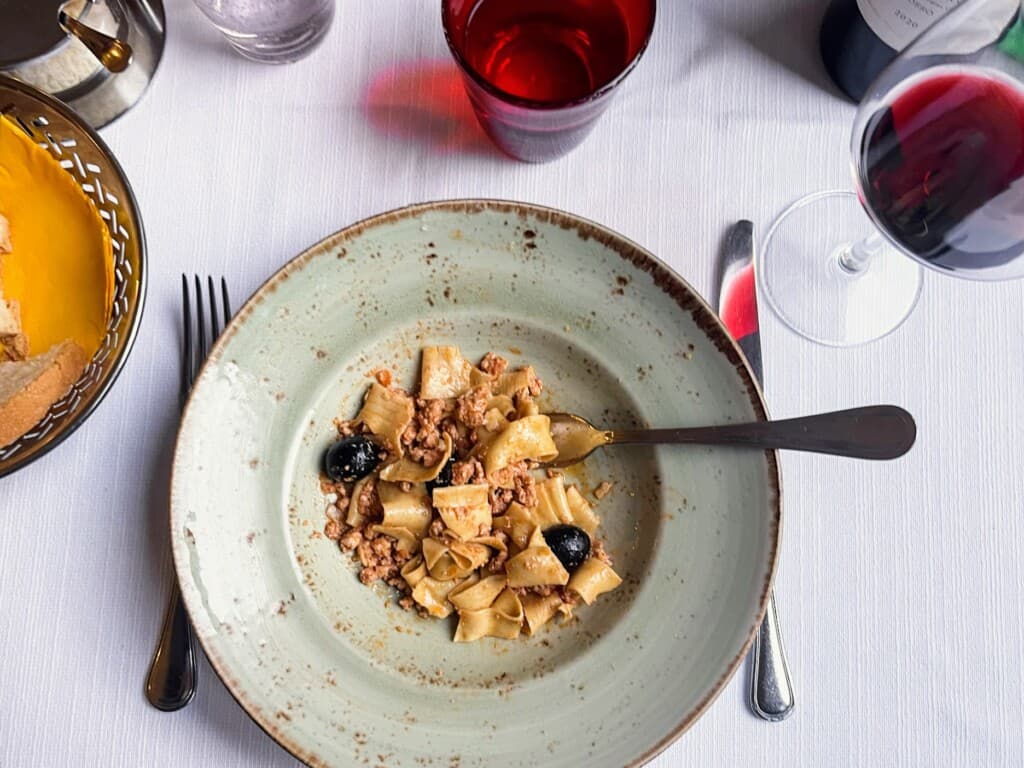
A Primo (plural primi) is the first large, (usually hot) course to come to the table. It’s heavier than an antipasto and usually carb heavy, but not always. They are typically not meat heavy but rather, made with a base of pasta, gnocchi, rice, polenta or in the form of a soup. They may have meat in them (such as pasta alla bolognese, with meat sauce) but the star is starch here.
Common Italian primi:
Italian Celebrations: It’s interesting to know that at weddings and grand celebrations, especially in the south like in Naples, meals are extra long. It’s not uncommon to be served multiple first course meals such as two pastas and a rice! And no, you can’t refuse them, it’s considered rude. The portions will be smaller but it’s anyhow a lot of food.
Secondo (Second Course)

A secondo (plural secondi) is the second course meal in Italy which is made up of different meat and seafood options, including egg dishes. What you find will be regional, seasonal and local. It might be chicken, stewed game, a steak, locally made sausages, grilled mixed meat or seafood prepared in various ways.
Common Italian secondi:
- Carne alla griglia/brace – grilled meat
- Spezzatino – beef stew
- pesce del giorno – fish of the day
- Scampi – prawns
- Coniglio in umido – stewed rabbit
- Faraona – guinea fowl
- Bistecca – steak
- Polpo – octopus
- Pollo – chicken
- Maiale – pork
Contorno (Vegetable)
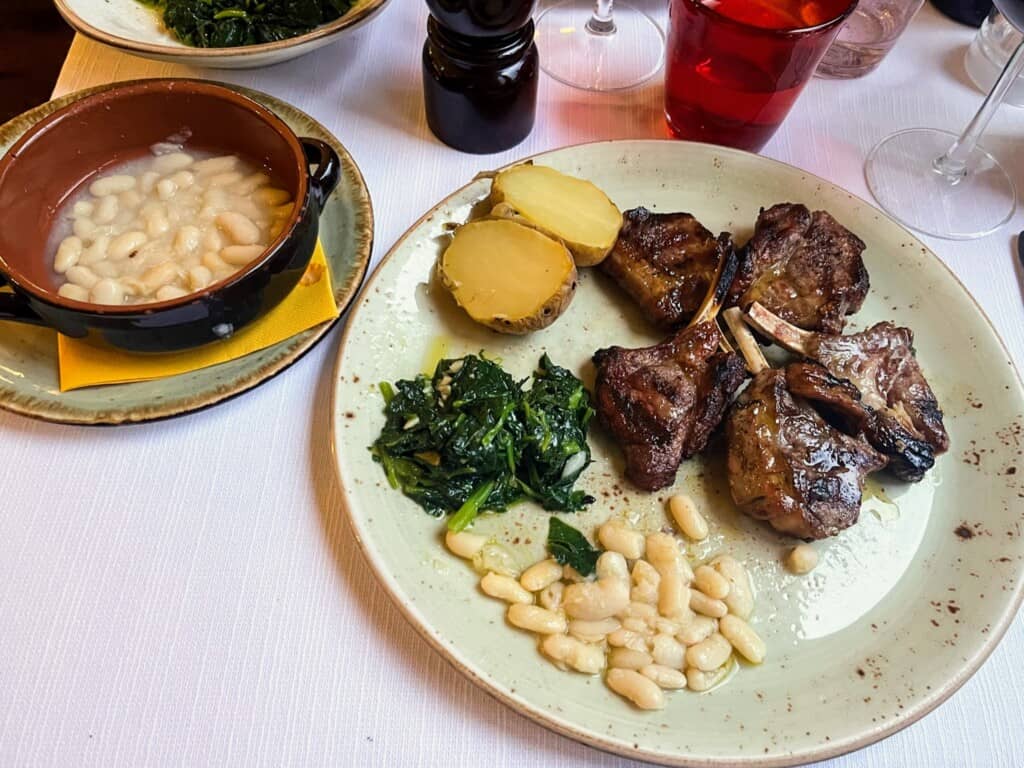
Contorni are side dishes that are served along the second course in Italy. They will be found in a separate section on menus and must be ordered separately as well. They will, however, be served with the second course on a small plate on the side, meant to be enjoyed simultaneously. Most of the time, they are simple and not overly complicated, meant to compliment the main dish.
Common Italian Contorni:
- patate arroste – roasted potatoes
- patate fritte – french fried
- puree di patate – mashed potatoes
- verdure saltate – sautéed vegetables, usually leafy greens.
- fagioli – beans/legumes
- verdure lesse steamed mixed vegetables
- verdure alla griglia – grilled mixed vegetables
Note: Salads may also be listed under contorni but not always (see below).
Vegetarians: You can find most of your vegetarian options under the contorno section of the menu. Check out my list of Vegetarian Dishes in to Try in Italy.
Insalata (Salad)
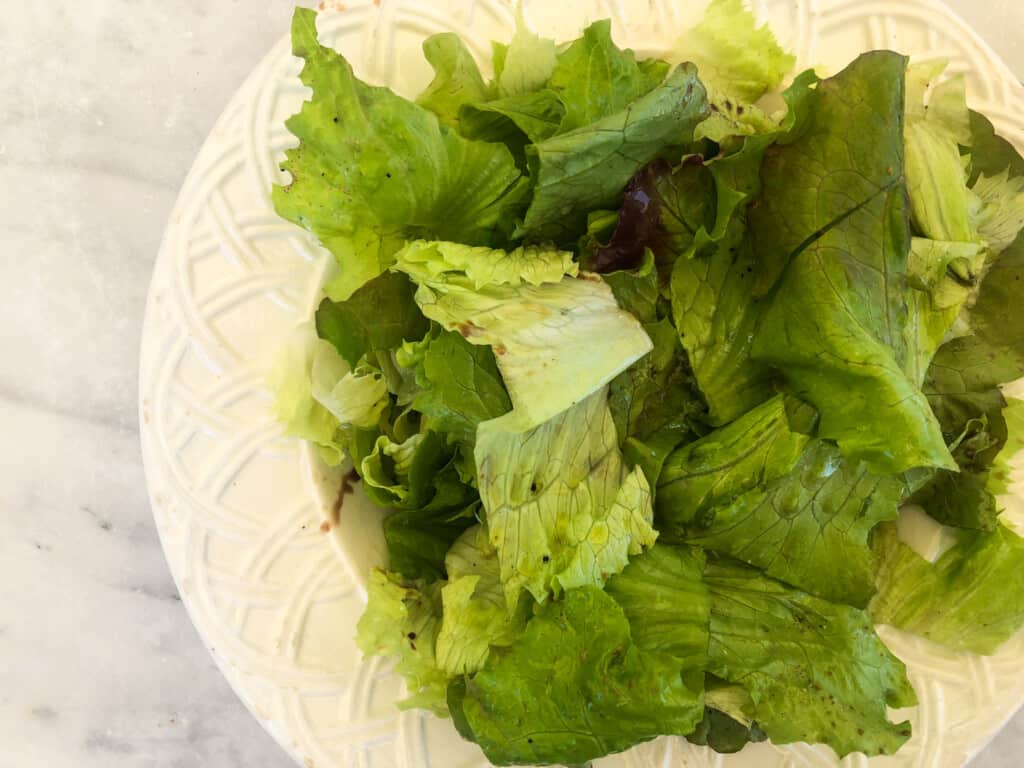
Italians won’t typically have a contorno and a salad course but rather, the salad is ordered with the secondo as a contorno. You might find a separate section under the menu entitled insalate, which will only list salad options but you will most likely be served it with other contorni with the meat or fish course.
The concept of a salad course is one that lives on only in very high-end or Michelin star restaurants. Salad is just another way to clear the palate and prepare for the next course. In everyday Italian dinner courses, the salad course and the side course are one in the same.
No matter the fact, a salad in Italian is going to be simple when served with a second course meal. It’s not going to be filled with toppings, crunchy bits or doused in a heavy dressing. Instead, it’s going to be a small bowl of leafy greens, perhaps a couple of chopped tomatoes at most and served with olive oil and vinegar to be dressed to each person’s liking.
Dolce (Dessert)
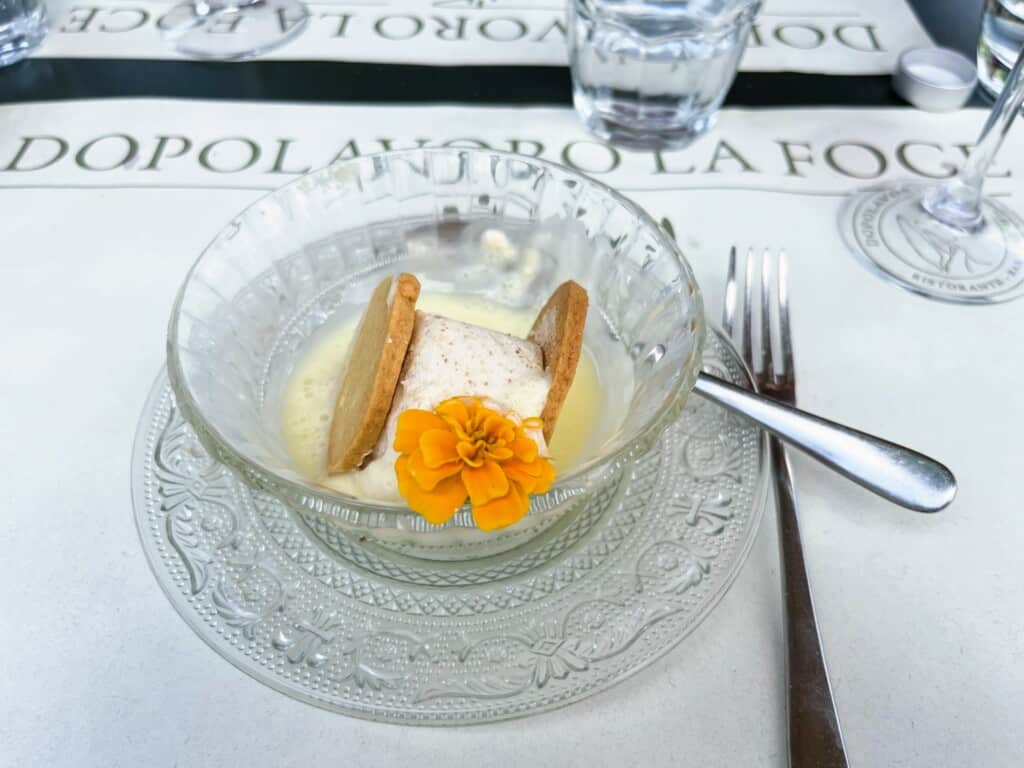
Italians always like to close their meal with something sweet or rich, even if it’s just a small nibble of aged cheese or a small piece of fruit like a mandarin orange. Even at home this is a common practice among Italians, not just a phenomenon that you see in restaurants.
Italian Desserts: If you love desserts, read Classic Italian Desserts to get the scoop on Italy’s most beloved desserts to try on your next trip to Italy.
Frutta E Formaggio (Fruit and Cheese)

Fruit and cheese, while might be considered by some to be a category of their own, are best categorized under dessert because it’s the rare case that you will have a separate fruit and cheese course if you are also ordering dessert.
Fruit and cheese will likely take the place of dessert, especially in places like Piedmont and the Aosta Valley where aged cheese is a big thing.
Fruit is often served after a meal at home. Italians don’t eat desserts everyday but they will always close their meal with a piece of fruit or a few nuts if nothing else is available. And I have to say that after living here for so long, it’s a practice that I have incorporated into my mealtime as well. It’s a good way to add fruit into your diet and also curves your sweet tooth.
Caffè (Coffee)

Italians are used to drinking so much caffè or strong espresso that they claim it doesn’t affect their sleep cycle. I can’t speak to this myself as I don’t drink espresso in the evenings but I can tell you it’s a very common practice. It’s said to help clear one’s palate after dessert.
Traditionally it’s served without milk or sugar, as is, but you will find that many Italians prefer their evening coffee sweetened.
Cappuccino or other milky beverages are not allowed according to Italian food ‘rules’ practiced by the locals. At most, you might ask for a caffè con un po’ di latte da parte (with a bit of milk on the side).
Nice To Know: Coffee is never served with dessert. It’s always served between dessert and the digestivo.
Digestivo (Digestif)
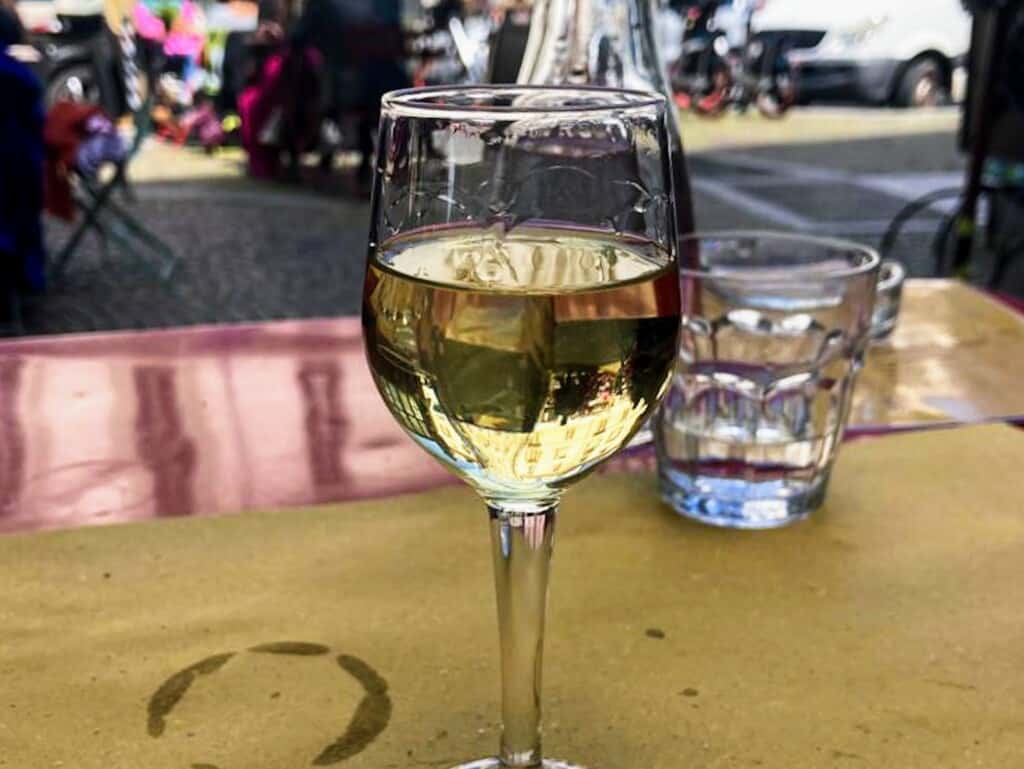
It only makes sense to close out your culinary experience, just as you opened it with an aperitivo. The digestivo is essentially your nightcap – your little nip of hard alcohol such as limoncello, amaro, or grappa to put you to bed and close out your evening.
Fun Fact: A digestivo is also known as an ammazzacaffè, meaning “kill the coffee”.
Italians take their digestive health very seriously and they say that a small sip of something like an amaro will help to digest and process your multi-course meal. Again, not sure about the science behind this but it’s nonetheless a fundamental part of the Italian dinner courses or formal meal structure.
Popular digestivi in Italy:
- Amaro Del Capo (amaro)
- Montenegro (amaro)
- Braulio (a herbal liqueur from the Valtellina region in Italy).
- Grappa (made from grape skins. I like al miele, made with honey)
- Mirto (made from the myrtle plant)
- Limoncello (lemon infused)
Nice To Know: At small, family-run places, it’s normal for the owner to set a couple of bottles of their in-house liquors on the table with some small glasses for you to serve yourself a digestive. This is not an opportunity to have several drinks but rather, the owner’s way of thanking you for being their guest.
Learn More: Read Italian Digestivo – Italy’s Top 5 Classic After-Dinner Drinks.
How To Read A Menu In Italy
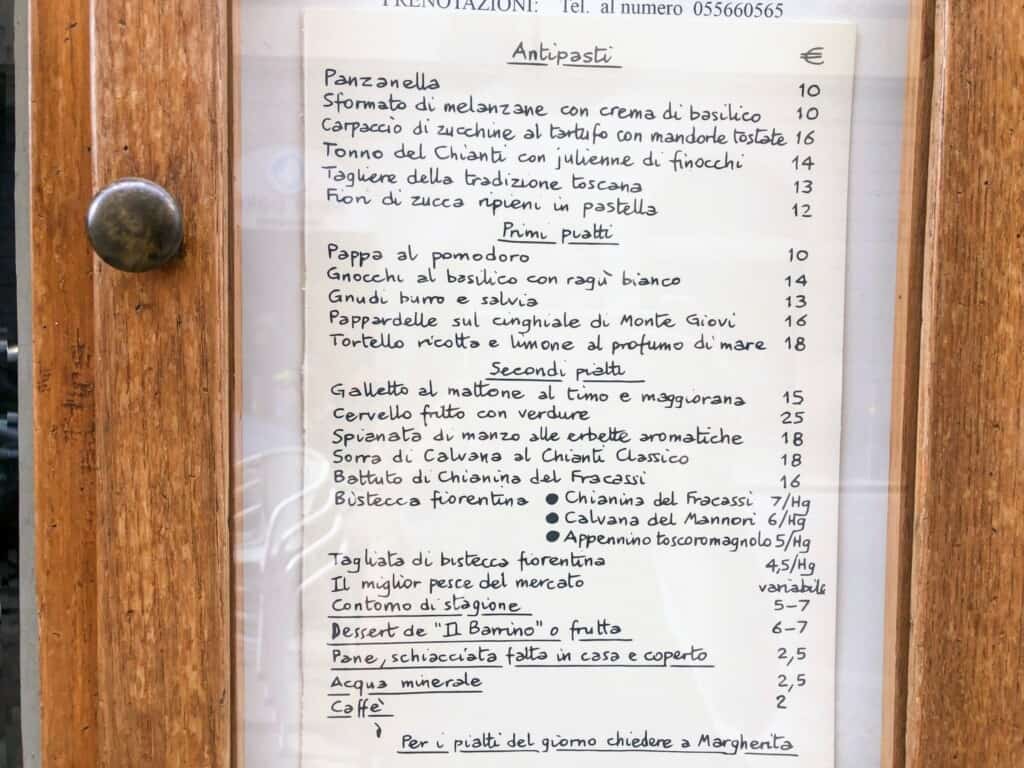
Menus in Italian restaurants are typically organized according to this same structure (except for aperitivo, which as mentioned, is held in a different location all together).
On a menu, you will see the food categorized under antipasti, primi, secondi, contorni and dolci. Usually coffee and after-dinner drinks won’t be listed on a menu. The dessert and wine might or might not be a separate menu all together.
But how are you going to work the timing out if everyone at the table is ordering different courses? For example, say you are having an antipasto and a primo but your partner is having a primo and secondo. How are they going to bring your food?
It’s important to note that unlike restaurants in other cultures, in Italian restaurants, the patron is assumed to be at the will of the restaurant. In other words, the customer doesn’t always know best. When you sit down, you are trusting the restaurant to make the best decisions for you. The waiter might ask how you want your food brought to the table but they also might decide how best to sort things out based on their experience, what pairs well and how many courses you are eating. If there is one main rule to keep in mind, Italians always eat in company, they rarely eat alone.
If you have a certain order or request for how the food comes out, just ask the waiter kindly and while they may not approve, they will accommodate you.
At Pizzerias: If you are at a pizzeria, you might notice that they serve primi and secondi as well. This is completely normal. If this is the case, you will find the pizza listed at the end of the menu.
Allergies & Dietary Restrictions in Italy: If you’re traveling in Italy and have special dietary needs, be sure to check out:
Eating with Dietary Restrictions in Italy
How to Eat Vegetarian In Italy
How to Eat Vegan in Italy
Eating Gluten-Free in Italy
Eating in Italy While Pregnant
Eating Dairy-Free in Italy
Eating Lactose-Free in Italy
Tips For Ordering Food In Italy
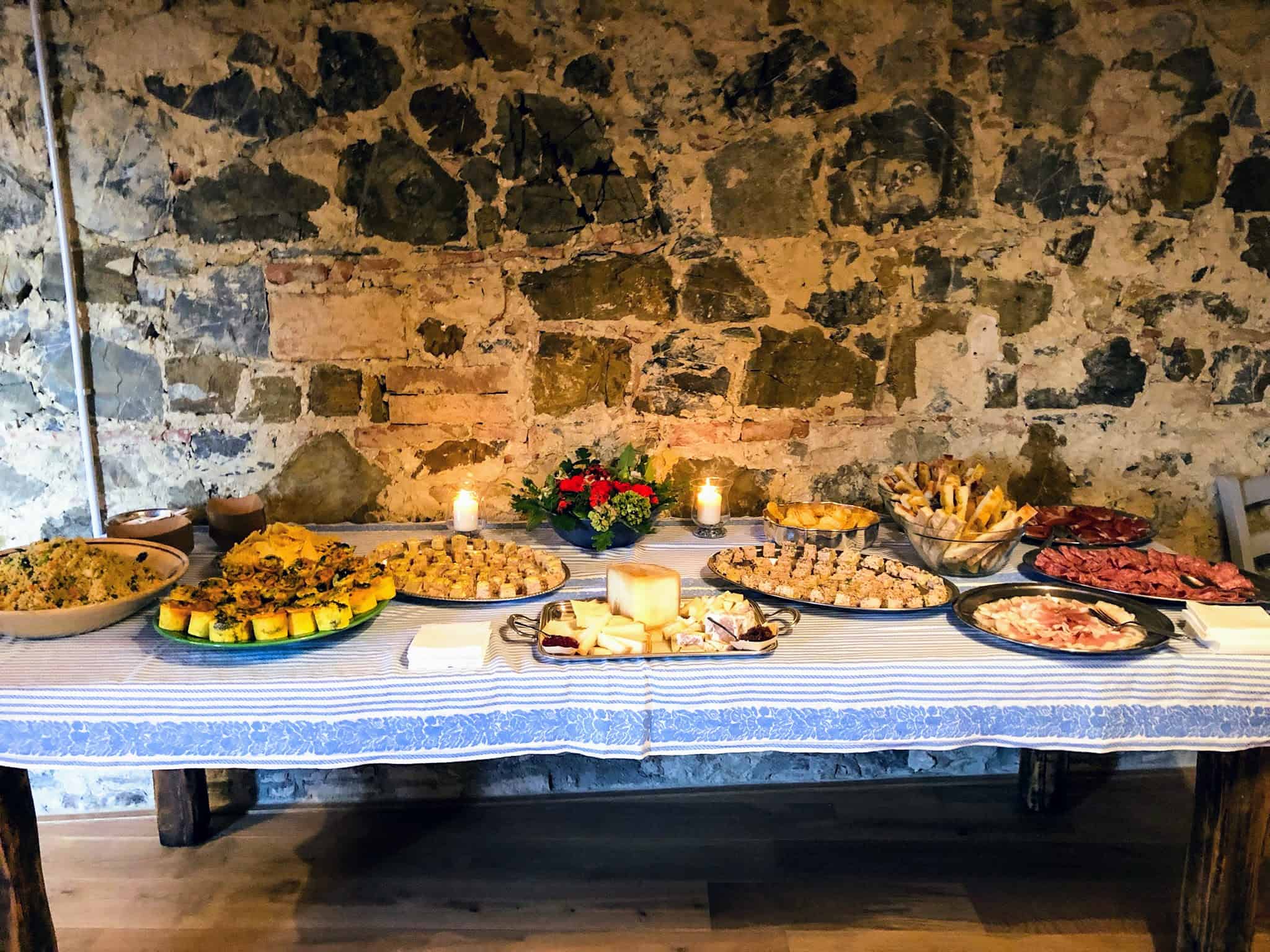
- Antipasto is all about the drink. Don’t overdo it with buffet-style aperitivo. Just have a few bites to tie you over until dinner.
- Sometimes a side dish is served with the main secondo. If so, it will be listed under the description. In this case, you may just want one other contorno, if any.
- Italians only order one primo and one secondo. They will never order two of the same category, including appetizers.
- It’s not good etiquette to make a meal out of appetizers without ordering anything else.
- Look for taglieri, meaning boards, either of formaggio (cheese) or salumi (cured meats) if you love cheese and cured meats under antipasti.
- Antipasti misto or mixed appetizers is a great way to sample and share various house and regional specialties on the menu.
- Generally speaking, restaurants expect you to order at least two categories on the menu. For example, an antipasto and a secondo or a primo and a secondo. Restaurants count on this to make money. Ordering only a primo that costs €12.00 isn’t going to make them money that evening.
For more information about how you will be charged and what you can expect in terms of tipping in Italy read Tipping In Italy – When & How Much and What is a Coperto? – All About Italy’s Cover Charge.
Look the Part: Check out these 5 Items Not to Wear When Dining Out in Italy and What to Wear to Dinner in Italy.

Italian Dinner Courses FAQ
In a traditional Italian dinner, you will have 7 courses, not all of which must be consumed in one sitting:
Aperitivo
Antipasto
Primo
Secondo
Contorno + insalata
Dolce, frutta/formaggio
Caffè/digestivo
A typical Italian dinner will usually incorporate at least two elements of a full seven course meal. This means that you might have an antipasto + a secondo course or a primo + secondo. Of course, you can order as many of these as you like but the general rule of thumb is at least two for good dinner etiquette while dining out.
The short answer is no, unless they are at a large celebration or event. Usually, Italians will order two of the categories and always have coffee to finish their meal.
The most traditional Italian meal will begin with an antipasto or starter, followed by a primo (starch), a secondo (protein) + contorno (side dish) and finished with a dolce or dessert followed by coffee and perhaps a digestif.
Dinner time will depend greatly on the time of year and the region you are in but generally speaking, between 8:00 pm and 10:00 pm.

